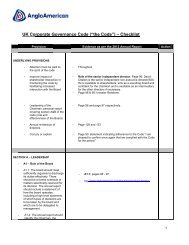Creating Value with the Future in Mind - Anglo American South Africa
Creating Value with the Future in Mind - Anglo American South Africa
Creating Value with the Future in Mind - Anglo American South Africa
You also want an ePaper? Increase the reach of your titles
YUMPU automatically turns print PDFs into web optimized ePapers that Google loves.
arro Alto<br />
water project<br />
Many of our operations are <strong>in</strong> waterstressed<br />
areas but even when access<br />
to this precious resource is not limited,<br />
we do our best to ensure we use it<br />
responsibly. Our Barro Alto nickel<br />
operation <strong>in</strong> Brazil embodies this<br />
commitment.<br />
As one of our most recent start-up<br />
operations – first metal was produced<br />
<strong>in</strong> March 2011 – we designed and built<br />
Barro Alto <strong>with</strong> an emphasis on best<br />
practice water stewardship. Us<strong>in</strong>g<br />
approximately 300,000 m 3 of water each<br />
month, it was important that we could<br />
demonstrate appropriate management<br />
<strong>in</strong> terms of both quantity and quality.<br />
Water for <strong>the</strong> operation is sourced<br />
from a fresh water river n<strong>in</strong>e kilometres<br />
from <strong>the</strong> site. From <strong>the</strong>re, we pump <strong>the</strong><br />
water to a l<strong>in</strong>ed dam capable of stor<strong>in</strong>g<br />
1.8 million m 3 . By l<strong>in</strong><strong>in</strong>g <strong>the</strong> dam we<br />
have avoided loss through <strong>in</strong>filtration,<br />
result<strong>in</strong>g <strong>in</strong> a sav<strong>in</strong>g of 438,000 m 3 a<br />
year, or 6% of total water requirements.<br />
Water is <strong>the</strong>n pumped from <strong>the</strong> dam to<br />
<strong>the</strong> site, where it is used <strong>in</strong> processes<br />
to cool <strong>the</strong> furnace and to granulate <strong>the</strong><br />
slag and metal. The closed-circuit system<br />
sees <strong>the</strong> water pumped back to <strong>the</strong> dam<br />
<strong>with</strong> no discharge from <strong>the</strong> operational<br />
processes. The quality of <strong>the</strong> water is<br />
checked aga<strong>in</strong>st 71 parameters –<br />
encompass<strong>in</strong>g biological, chemical<br />
and physical conditions – before and<br />
after it has been used, to determ<strong>in</strong>e<br />
any changes.<br />
In an effort to mitigate <strong>the</strong> impact on<br />
<strong>the</strong> river, <strong>the</strong> operation also draws<br />
20% of its water requirements from<br />
ra<strong>in</strong>water. Ra<strong>in</strong> channels around <strong>the</strong><br />
plant collect water which <strong>the</strong>n flows<br />
naturally to <strong>the</strong> dam. This provides<br />
for all <strong>the</strong> plant’s water requirements<br />
for three to four months of <strong>the</strong> year,<br />
dur<strong>in</strong>g which time <strong>the</strong>re is no need<br />
for energy-<strong>in</strong>tensive pump<strong>in</strong>g of<br />
fresh water. Some 800,000 m 3 per<br />
annum of ra<strong>in</strong>water is captured and<br />
used <strong>in</strong> this way.<br />
Thanks to <strong>the</strong>se measures,<br />
Barro Alto now re-uses 85–87%<br />
of its water – around 10% higher<br />
than levels achieved at equivalent<br />
older m<strong>in</strong>e operations – and has<br />
been recognised by local<br />
environmental bodies.<br />
Image<br />
Otavio Lopes, an environmental eng<strong>in</strong>eer<strong>in</strong>g<br />
coord<strong>in</strong>ator, samples water quality at a<br />
Barro Alto pump station.<br />
Total water consumed<br />
2008–2012<br />
(million m 3 )<br />
180<br />
162<br />
144<br />
126<br />
108<br />
90<br />
72<br />
54<br />
36<br />
18<br />
0<br />
2008 2009 2010 2011<br />
<strong>Anglo</strong> <strong>American</strong> actual<br />
Bus<strong>in</strong>ess-as-usual (BAU) basel<strong>in</strong>e<br />
2012<br />
externally – though <strong>the</strong> relevant<br />
authorities are kept <strong>in</strong>formed about<br />
<strong>in</strong>cidents until <strong>the</strong>y are entirely<br />
resolved. Dur<strong>in</strong>g 2012, <strong>in</strong> relation to<br />
water, we confirmed seven Level 3<br />
environmental <strong>in</strong>cidents, one Level 4<br />
<strong>in</strong>cident and no Level 5 <strong>in</strong>cidents (see<br />
<strong>in</strong>cident def<strong>in</strong>itions on page 78). The<br />
Level 3 <strong>in</strong>cidents <strong>in</strong>volved unplanned<br />
discharges, where immediate remedial<br />
action was taken to mitigate <strong>the</strong><br />
impact of each <strong>in</strong>cident. None of<br />
<strong>the</strong>se receiv<strong>in</strong>g water bodies was<br />
significantly affected by <strong>the</strong> <strong>in</strong>cidents.<br />
A number of longer-term <strong>in</strong>terventions<br />
rema<strong>in</strong> <strong>in</strong> progress to avoid repeat<br />
<strong>in</strong>cidents. The Level 4 <strong>in</strong>cident <strong>in</strong>volved<br />
effluent from our sewage treatment<br />
plant at LLX M<strong>in</strong>as-Rio at Açu Port<br />
<strong>in</strong> Brazil exceed<strong>in</strong>g legal standards.<br />
Operational personnel immediately<br />
<strong>in</strong>vestigated water sources enter<strong>in</strong>g<br />
<strong>the</strong> plant that could have caused <strong>the</strong><br />
issue and have implemented additional<br />
ma<strong>in</strong>tenance measures to avoid<br />
repeat <strong>in</strong>cidents.<br />
<strong>Anglo</strong> <strong>American</strong>’s exposure to acid<br />
rock dra<strong>in</strong>age (ARD) <strong>in</strong> sou<strong>the</strong>rn <strong>Africa</strong><br />
is limited to some of our Thermal Coal<br />
m<strong>in</strong>es <strong>in</strong> <strong>the</strong> country’s Mpumalanga<br />
prov<strong>in</strong>ce, where <strong>the</strong> geology is<br />
predisposed to acidity. We have<br />
mitigated <strong>the</strong> risk of ARD impact<br />
through <strong>the</strong> development of a water<br />
reclamation plant <strong>in</strong> eMalahleni and<br />
two mobile water treatment plants.<br />
The water reclamation plant, built <strong>in</strong><br />
partnership <strong>with</strong> BHP Billiton and <strong>the</strong><br />
eMalahleni Municipal Council <strong>in</strong> 2007,<br />
currently treats around 25–30 Ml per<br />
day of acid m<strong>in</strong>e water from four m<strong>in</strong>es.<br />
We are currently expand<strong>in</strong>g <strong>the</strong> facility<br />
to double its capacity, <strong>with</strong> a planned<br />
completion date of end-2013. In<br />
addition to address<strong>in</strong>g ARD at its po<strong>in</strong>t<br />
of impact by treat<strong>in</strong>g affected water,<br />
we seek to avoid its occurrence <strong>in</strong> <strong>the</strong><br />
first <strong>in</strong>stance through, for example,<br />
design<strong>in</strong>g our new m<strong>in</strong>es differently,<br />
concurrent rehabilitation of open-cut<br />
operations and <strong>the</strong> effective<br />
rehabilitation of waste facilities.<br />
Manag<strong>in</strong>g our impact on <strong>the</strong> environment<br />
<strong>Anglo</strong> <strong>American</strong> plc Susta<strong>in</strong>able Development Report 2012 59



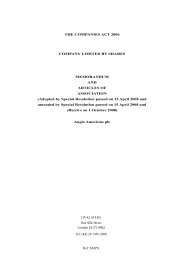
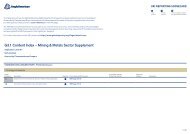

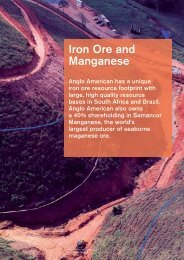
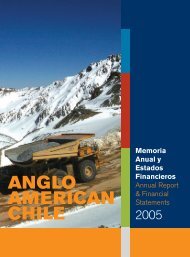
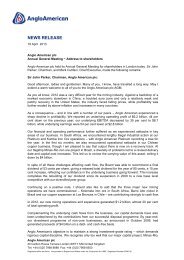
![English PDF [ 189KB ] - Anglo American](https://img.yumpu.com/50470814/1/184x260/english-pdf-189kb-anglo-american.jpg?quality=85)
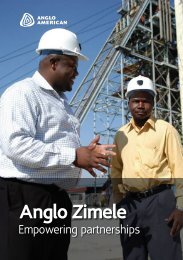

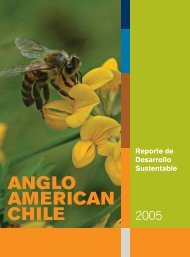

![pdf [ 595KB ] - Anglo American](https://img.yumpu.com/49420483/1/184x260/pdf-595kb-anglo-american.jpg?quality=85)
![pdf [ 1.1MB ] - Anglo American](https://img.yumpu.com/49057963/1/190x240/pdf-11mb-anglo-american.jpg?quality=85)
